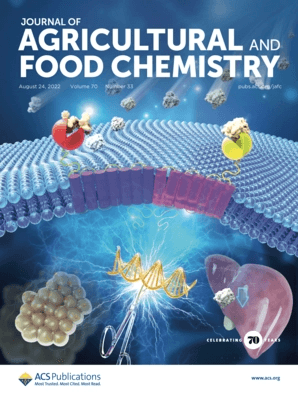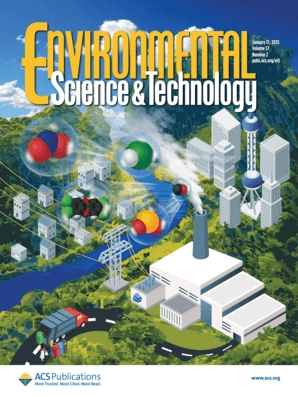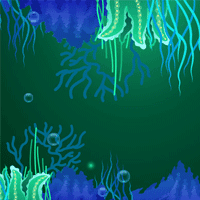In celebration of Earth Week 2023, we invite you to take a deeper look into some of the exciting research included in the “Chemists Celebrate Earth Week: The Curious Chemistry of Amazing Algae” Virtual Issue from ACS Journals.

Algae are a fascinating and diverse group of organisms that play a crucial role in the health and sustainability of our environment. These photosynthetic creatures are responsible for producing more than half of the atmosphere’s oxygen supply, and they are a widely available source of food and energy for many marine-dwelling species.
Despite these numerous benefits, the phrase “too much of a good thing” unfortunately rings true in the case of algae. When algae grow and multiply too quickly, they form harmful algal blooms that release toxins into the environment. Harmful algal blooms are exacerbated by external factors such as urbanization, population growth, and the leaching of chemicals such as nitrogen and phosphorus into the water.
Cyanobacteria (blue-green algae) and their harmful blooms have become an ever-increasing global environmental concern in recent decades. Found primarily in freshwater, harmful cyanobacterial blooms can cause illnesses in both people and animals through contaminated drinking water and air pollution. However, recent studies are unveiling novel approaches to monitor and control dangerous cyanobacterial growth—and even harvest it in a way that may help reduce the overall carbon footprint.
Environmentally Friendly Algaecide
To combat these harmful cyanobacterial blooms, a team of researchers in China wanted to develop a chemical approach that would effectively eliminate the harmful algae without leaving residual traces and damaging aquatic environments. They found their answer in the form of a new eco-friendly algaecide named Q2.
After exposing this new algaecide to a variety of specimens, the authors report that Q2 effectively inhibited cyanobacterial growth through photosynthesis disruption without harming other types of algae. The team also tested Q2’s potential impact on other aquatic life zuch as zebrafish embryos, and they found that it had no negative impact on the hatching and survival rates. Q2 even helped to increase the prevalence of Mesorhizobium, a helpful bacterium that produces vitamin B12.
Overall, this study, published in the Journal of Agricultural and Food Chemistry, demonstrates that Q2 is a promising solution for controlling harmful cyanobacterial blooms without damaging other aquatic life or the environment.

Development of a Potentially New Algaecide for Controlling Harmful Cyanobacteria Blooms Which is Ecologically Safe and Selective
A Novel, Open-Source Data Buoy System
Climate change has led to a steady increase in lake water temperatures throughout the USA, which in turn has contributed to the growing problem of harmful cyanobacterial algal blooms in many freshwater lakes. Scientists at the University of Wisconsin-Milwaukee, USA, developed a novel, open-source data buoy system—the Panther buoy—to better monitor these blooms and the associated environmental conditions triggering their rapid growth.
The team deployed the Panther buoys in several locations in Green Bay, an arm of Lake Michigan, and in Lake Superior, to monitor water temperature, fluorescence of chlorophyll-a and phycocyanin, wind, and other conditions associated with cyanobacterial algal blooms. Their findings, published in ACS ES&T Water, demonstrate the Panther buoy’s effectiveness for monitoring both harmful cyanobacterial algal blooms and related water and environmental parameters.
The researchers report that this “pseudo-DIY” system could be valuable for others to replicate themselves and use for continuous monitoring of water quality and algal bloom activity. Furthermore, the Panther buoy is relatively cheaper to construct compared to similar data systems, making it a more accessible option for global freshwater use.

Real-Time Monitoring of Cyanobacterial Harmful Algal Blooms with the Panther Buoy
Controlling Harmful Algal Blooms with Electrochemical Oxidation
Some of the most harmful toxins produced from cyanobacterial harmful algal blooms are microcystins, which are difficult to eradicate and can lead to liver and brain damage. A group of chemists in New York, USA, wanted to identify a more effective method of treating recreational lake water beyond physical filters and chemicals.
In a recent article published in ACS ES&T Engineering, the authors present a technique called electrochemical oxidation and filtration (EOF), which involves passing water through an electrified porous anode and has proven successful in removing various types of algae from water.
To test EOF’s effectiveness on mitigating cyanobacteria and cyanotoxins, the team designed and distributed a full-scale EOF system on a pontoon boat and monitored the system over the course of five days. The authors report that whereas the EOF process is quick and easy to operate, the technology may be best used to target early-stage algal blooms located at the surface of the water. Furthermore, EOF technology could one day be used to help drinking water plants pretreat water from sources that may be susceptible to harmful blooms.
Cleaning Up with Thermochemical Conversion
Since algae take in a robust amount of carbon and nutrients, wouldn’t it be great if there was a way to use them effectively to fight climate change and water pollution? Once again, chemistry has come to the rescue in the form of thermochemical conversion, an approach that can convert algae biomass into valuable carbon materials and biofuels—and one that is much more sustainable than traditional conventional landfill methods.
In this study, the authors performed a “cradle-to-grave” life cycle assessment to identify the overall environmental impact of the thermochemical conversion process compared to traditional landfilling methods. Their findings, published in Environmental Science & Technology, present a few trade-offs: thermochemical conversion exhibited relatively high environmental burdens on fossil fuel, metal, and water depletion, among others; alternatively, this process results in much lower burdens on hazards such as environmental and human toxicity and freshwater eutrophication.
Although more research is still needed in this area, these findings present thermochemical conversion as a promising approach for algae biomass treatment with various environmental benefits.

Sustainable Conversion of Harmful Algae Biomass into a CO2 Reduction Electrocatalyst for Two-Fold Carbon Utilization


